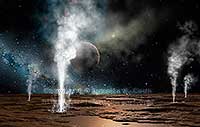
KBO with Geysers Erupting geysers dot the surface of a Kuiper Belt object. A moon hovers overhead and beyond it, the dim Sun.
 Milky Way and Satellites
The Sagittarius Dwarf Galaxy and its star stream gracefully arc around the Milky Way. Several other dwarf galaxies reside in the neighborhood: the Large and Small Magellanic Clouds (lower left), Segue 1, and Ursa Major II (small fuzzy shapes, top center). Also shown are the bubbles of hot gas that extend above and below the galactic plane.
Milky Way and Satellites
The Sagittarius Dwarf Galaxy and its star stream gracefully arc around the Milky Way. Several other dwarf galaxies reside in the neighborhood: the Large and Small Magellanic Clouds (lower left), Segue 1, and Ursa Major II (small fuzzy shapes, top center). Also shown are the bubbles of hot gas that extend above and below the galactic plane.
 New Milky Way
A polar view of the Milky Way, with its central bar and complex arm structure.
New Milky Way
A polar view of the Milky Way, with its central bar and complex arm structure.
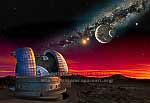 European Extremely Large Telescope (E-ELT)
Size matters! This giant's huge, light-gathering mirror will be 42 meters across, enabling it to directly image Earth-like planets, study their atmospheres, and resolve the stars of distant galaxies. First light is expected to begin in the early 2020s. Shown in the sky are an extrasolar planet system and the Milky Way.
European Extremely Large Telescope (E-ELT)
Size matters! This giant's huge, light-gathering mirror will be 42 meters across, enabling it to directly image Earth-like planets, study their atmospheres, and resolve the stars of distant galaxies. First light is expected to begin in the early 2020s. Shown in the sky are an extrasolar planet system and the Milky Way.
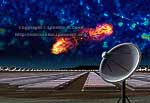 Square Kilometre Array (SKA) at HR8799
When this array is completed in the 2020s it will be the largest telescope in the world, boasting around a million square meters of collecting area via a central core of instruments that is surrounded by smaller outlying groups. From the SKA's data will come new understanding about the first galaxies and the metallicity of the universe. Two pulsars and a radio galaxy appear against a background pattern that depicts the re-ionization of the universe.
Square Kilometre Array (SKA) at HR8799
When this array is completed in the 2020s it will be the largest telescope in the world, boasting around a million square meters of collecting area via a central core of instruments that is surrounded by smaller outlying groups. From the SKA's data will come new understanding about the first galaxies and the metallicity of the universe. Two pulsars and a radio galaxy appear against a background pattern that depicts the re-ionization of the universe.
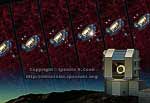 Large Synoptic Survey Telescope (LSST)
During approximately ten years of operation this telescope will take multiple images of the same areas of space, comparing them to find any differences that point to asteroids (including potentially threatening near-Earth asteroids), supernovae, and other objects that otherwise would be missed. Construction should be finished by 2023.
Large Synoptic Survey Telescope (LSST)
During approximately ten years of operation this telescope will take multiple images of the same areas of space, comparing them to find any differences that point to asteroids (including potentially threatening near-Earth asteroids), supernovae, and other objects that otherwise would be missed. Construction should be finished by 2023.
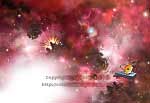 James Webb Space Telescope (JWST)
Sometimes considered the successor to the Hubble Space Telescope, this instrument is optimized for the infrared and will probe the early universe just after the Big Bang. The JWST will examine first stars and other early objects, as shown here by the regions of stellar birth. The target launch date is 2018.
James Webb Space Telescope (JWST)
Sometimes considered the successor to the Hubble Space Telescope, this instrument is optimized for the infrared and will probe the early universe just after the Big Bang. The JWST will examine first stars and other early objects, as shown here by the regions of stellar birth. The target launch date is 2018.
 Milky Way Center
Astronomers believe that a black hole lies at the center of the Milky Way Galaxy. An accretion disk of gas and dust surrounds the black hole and this, in turn, is orbited by many massive, young stars. Clouds of interstellar dust reflect the light from flares resulting from gas passing into the black hole. The Arches Cluster, a massive group of young stars, appears at the upper left.
Milky Way Center
Astronomers believe that a black hole lies at the center of the Milky Way Galaxy. An accretion disk of gas and dust surrounds the black hole and this, in turn, is orbited by many massive, young stars. Clouds of interstellar dust reflect the light from flares resulting from gas passing into the black hole. The Arches Cluster, a massive group of young stars, appears at the upper left.
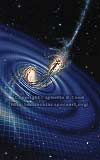 Gravitational Waves
Colliding galaxies emit gravitational waves, otherwise known as ripples in space-time. While believed to exist, direct detection has not yet occurred. This image is available in several versions, including one with the Laser Interferometer Space Antenna (LISA).
Gravitational Waves
Colliding galaxies emit gravitational waves, otherwise known as ripples in space-time. While believed to exist, direct detection has not yet occurred. This image is available in several versions, including one with the Laser Interferometer Space Antenna (LISA).
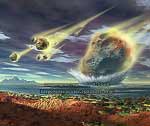 Sudbury Impact
About 1.8 billion years ago a huge object from space crashed into a calm sea at what is now Sudbury in Ontario, Canada. The impact displaced more than 6500 cubic miles of debris which scattered over nearly 1 million square miles.
Sudbury Impact
About 1.8 billion years ago a huge object from space crashed into a calm sea at what is now Sudbury in Ontario, Canada. The impact displaced more than 6500 cubic miles of debris which scattered over nearly 1 million square miles.
![[Thumbnail]](img/tsolsys2006.jpg) Solar System 2006
With the demotion of Pluto to "dwarf planet" status by the International Astronomical Union on August 24, 2006, the Solar System now has only eight planets.
Solar System 2006
With the demotion of Pluto to "dwarf planet" status by the International Astronomical Union on August 24, 2006, the Solar System now has only eight planets.
![[Thumbnail]](img/tsolsys2006ii.jpg) Solar System 2006 II
Our "new" Solar System of eight planets is shown here with all the bodies to scale and in order from the Sun.
Solar System 2006 II
Our "new" Solar System of eight planets is shown here with all the bodies to scale and in order from the Sun.
![[Thumbnail]](img/tplancand.jpg) Planet Candidates
The continuing debate over which celestial bodies are worthy of planet status in our Solar System include several candidates: select Trans-Neptunian Objects and asteroids, along with Pluto and Charon.
Planet Candidates
The continuing debate over which celestial bodies are worthy of planet status in our Solar System include several candidates: select Trans-Neptunian Objects and asteroids, along with Pluto and Charon.
![[Thumbnail]](img/tpluto2006.jpg) Pluto and Satellites
Pluto is accompanied by Charon and its two recently-discovered smaller satellites.
Pluto and Satellites
Pluto is accompanied by Charon and its two recently-discovered smaller satellites.

 org
org